For Ugandans, by Ugandans
Being the Change
Daniel Morgan ('10) found solutions that come from within a community are the key to sustainable change
By Martha Bell Graham

It takes something more fundamental than enthusiasm, money, time — or even commitment — to permanently change the world. Daniel Morgan ('10) knows this well. After multiple trips to Uganda, Morgan has learned that one critical aptitude supersedes all others in the pursuit of lasting, sustained change.
That aptitude is the determination to understand native people, their needs and their desires. It is the ability to value and nurture their willingness and ability to create their own futures. But most importantly, it is acquiring the understanding that for Uganda to be changed it must be done by Ugandans.
"What they truly need is self-respect and self-empowerment," Morgan says. "I've learned that when an expatriate 'comes in with a solution,' it almost always stifles the 'can-do' attitude within the community. The solution should come from within the community, that way, when the expatriate leaves — even if he helped spur that solution on — the people have the excitement and empowerment to change their own situations in the future."
When Morgan first traveled to Gulu, Uganda, in the summer of 2008 as part of a church mission trip, he headed there with the typically abundant enthusiasm many students have to change the world. Uganda, landlocked in East Africa, is a poor country torn by decades of civil war, but — as Morgan learned — the people of Uganda are rich with compassion, generosity and talent.
As a designer Morgan also saw the beauty and creativity of the world Ugandans inhabit: the sheer beauty and ingenuity of the thatched structures they build, the enthusiasm they exhibit for creation and their willingness to work hard.
As an observer coming from the abundance of the "can-do" American culture, he watched the Ugandan people make bricks, a hard, long and labor intensive process. He wondered: Could the brick making process be improved?
"Perhaps I should have wondered," he says now, "'would improving the brick process really improve the status quo?'"
After returning to JMU the following fall, and calling on his own creativity as a sculpture major, the young art major from Lynchburg designed a mixer that he believed would help the Ugandan people perform this important task faster and easier. His idea gained significant traction when he engaged the support of Ferguson Industrial Plastics. Eventually, the company produced a large, shiny and expensive mixer, which Morgan and their engineers had designed.
A better way to help
Here, however, is where the story diverges. As Morgan grew to know the Ugandan people, he grasped a better way to help. He quickly realized that the shiny, American-made $5,000 mixer was a failure.
So the next year Morgan made another mixer while he was in Uganda — this one fashioned out of materials scavenged around the local market. "It might not be as efficient, or work as quickly, but the $150 version was more successful in Uganda because it's easy to understand how it works, it's easy to fix when it breaks, and it's not intimidating to use."
"This version was a collaboration with Ugandan minds, which is why it turned out better, I am sure," he says. "It fit better into the Ugandan culture."
Sustainable design — the kind that lasts — must originate from the culture, Morgan learned. Designers can create a product that is faster, smoother, more efficient, but Morgan says, "If it isn't culturally acceptable, then it won't get used, no matter how efficient it is. For a design to truly arise from within a culture, it doesn't mean the designer is living in the culture, it means the designer is of the culture. A Ugandan design from a Ugandan.
Co-designing the future
If a product uses "local materials and methods, then we can get the product made in-country, which fuels the local economy," Morgan says — another plus. "And when using local materials the product will most likely be more culturally sensitive by nature."
Creating inventions whose genesis is in the local society rather than in a wealthy, developed nation, is not always easy and is not accomplished without taking the time to learn, appreciate and value the native culture.
"Assuming one day I became a good enough designer that I could come up with culturally sensitive products that help areas of life here, should I make it my life's ambition to do so?" Morgan says. "I used to think so. But to achieve true, sustained development, we need to be creating more than good designs. We need to create good designers — people who have been raised in this culture and who know intimately the cultural norms and constraints that they are designing within. These young creatives will then take the reins from expatriate designers and start innovating solutions to their own problems."
It is through these experiences that Morgan learned the critical importance of "co-designing." "It doesn't matter how long I stay here, the locals will always know the culture better than I and therefore be in a far better place to be solving problems."
Morgan believes that the creativity needed for change is already in Uganda. He interned last summer in Kampala, and returned in the fall, to work with Dr. Moses Musaazi, who was educated at Imperial College of London and returned to teach engineering at Makerere University in Kampala. Musaazi founded Technology for Tomorrow, a company creating sustainable solutions to environmental and economic problems in East Africa. Here Morgan saw firsthand the value of co-design and of generating and encouraging the creative spirit of indigenous peoples.
During his seven-week stint, he worked on alternatives to cement in brick making, on the design of ultra-low cost skylights and on banana fiber as a roofing material. He also worked on that second mixer. "This was a really fun project because I got to create this Frankenstein-machine made from old car parts, an old 55-gallon drum and various scrap metal."
Empower change
While the potential for change exists, there are still hurdles to overcome. Morgan cites Thomas Edison's famous statistics: 10,000 failures for one success. Even in the United States, the speculative nature of design is often shunned as impractical, or worse as too expensive. In Kampala and in developing nations the perceived and real expense of creativity is a luxury that might seem frivolous in a country where poverty is endemic.

Morgan says for development efforts to truly work they must be sensitive to local culture.
"The problem is compounded in the developing world because people are so worried about making a decent living that they don't think it's responsible to develop those creative skills." But that's a false notion because creativity drives innovation, which will eventually lead to development.
"I think the best way to help achieve change is to cultivate the changes already budding from within, or by empowering local students to create change they deem important."
Morgan cites an example: "Even the second mixer, though it is more 'appropriate' than its predecessor in every way, is still not an example of ethical aid. Though it was a co-design, because I was driving the project, it was not 'owned' by the nationals. This is the root of the problem with so much aid today. Yes, the device might make construction easier, but it does not make anyone less poor. It doesn't make them realize their potential and strive for a new future they own."
Change that is truly sustainable, Daniel learned, is by Ugandans for Ugandans. A future they own.
